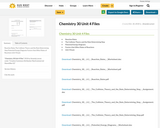
Reaction Rates
The Collision Theory and the Rate Determining Step
Potential Energy Diagrams
Factors that Affect Rates of Reactions
Unit 4 Exam
- Subject:
- Chemistry
- Science
- Material Type:
- Activity/Lab
- Unit of Study
- Date Added:
- 10/18/2018

Reaction Rates
The Collision Theory and the Rate Determining Step
Potential Energy Diagrams
Factors that Affect Rates of Reactions
Unit 4 Exam
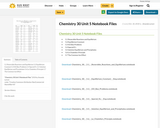
5.1 Reversible Reactions and Equilibrium
5.2 Equilibrium Constant
5.3 ICE Box Problems
5.4 Special K's
5.5 Solution Equilibrium and Precipitates
5.6 Le Chateliers Principle
5.7 The Common Ion Effect
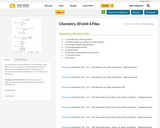
6.1 Introduction to Acids and Bases
6.2 The Bronsted- Lowry Theory of Acids and Bases
6.3 Strong and Weak Acids and Bases
6.4 Calculating H3O and OH
6.5 the pH Scale
6.6 Indicators, Neutralization, and Titrations
6.7 Titration Curves
Unit 6 Exam
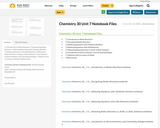
7.1 Introduction to Redox Reactions
7.2 Recognizing Redox Reactions
7.3 Balancing Equations with Oxidation Numbers
7.4 Balancing Equations with Half Reactions
7.5 Balancing Redox Reactions in Acidic or Basic Solutions
7.6 Introduction to Electrochemistry and Calculating Voltages
7.7 Batteries and Corrosions of Metals
7.8 Electrolysis

This concentration level course is a study of the physical, perceptual, cognitive, personality, and language developmental stages of children from conception through adolescence, including the principle theories of development and their application. The need for an understanding of how children develop and what influences their development is an important component of contributing to the demands of our complex society. Students will develop an understanding of children and the developmental process through readings, case studies, observations, individual research projects and group project work. Active class participation is enhanced by limited community classroom placement under the guidance of a mentor teacher. All students are required to observe and/or participate in settings and classrooms at the preschool/primary/elementary or middle/junior high levels at the end of the Spring semester.
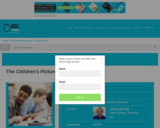
In this lesson students evaluate published children's picture storybooks. Students then plan, write, illustrate, and publish their own children's picture books.

Students analyze ńchoose your own adventureî stories and brainstorm to develop setting, characters, and plots for their own adventures stories and related Websites.

Concentus provides a full downloadable unit with a teacher and student resource booklet. This unit focuses on citizenship and aims to meet the following goals:Foster Engaged citizens who question, critically examine, advocate, and defend rights and responsibilities embedded in democracy at the local, regional, provincial, national, and global levels.Foster Lifelong learning citizens who continuously strive to understand the dynamics of change in society, and they critically seek new information to make reasoned and unbiased decisions.Foster Citizens with a strong sense of self, community, and place who value and demonstrate a positive commitment to understanding these concepts as citizens, and to the exploration of citizenship responsibilities inherent in these relationships at local, regional, national, and global levels.

Modules for teachers include:
*Overview & Syllabus
*Intro
*Readiness Pre-Assessment
*Formative Assessment
*Data Informed Instruction
*Summative Classroom Assessment
*Putting the Pieces Together
Classroom Assessment in a Remote Learning Environment

Students are challenged to design a method for separating steel from aluminum based on magnetic properties as is frequently done in recycling operations. To complicate the challenge, the magnet used to separate the steel must be able to be switched off to allow for the recollection of the steel. Students must ultimately design, test, and present an effective electromagnet.
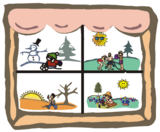
"Students have an opportunity to discuss clothing in relation to the environment. During the learning activities, students will become familiar with different weather conditions, record information related to clothing and weather, determine criteria for wearing certain clothing, categorize clothing according to weather conditions, and prepare and present a dialogue related to the topic. For the experiential goal, students will present a mannequin, stuffed animal, doll, etc. dressed according to certain weather conditions and complete a paragraph." Instructions are in English.
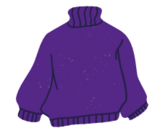
This thematic unit from Comox Valley Schools (SD71) in B.C. is aimed at Grade 6 Core French students, but is suitable for younger grades and would be easily adaptable for older ones. It is focused on oral practice and participation and would also be useful in primary French Immersion classes!Content Authors: Comox Valley Schools, Learn71, Beth Peddle

"Cocoa Ice" is set in the early 1800s and describes the exchange that occurs when a trading ship from Maine travels to the Caribbean village of Santo Domingo. The story is told in two parts, each part narrated by a girl who lives in one of these locations.
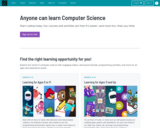
FULL COURSES are available here for students.
Learn to make your own game, app, or computer drawing. (K-5)
Build real working apps, games and websites using blocks, JavaScript, CSS, HTML and more. (6-9)
Go beyond Code.org and take university courses online or learn a new programming language. (10-12)
Plus access to all the Hour of Code games/coding activities!

Anyone can learn computer science! Over 70 million students have learned on Code.org!
Get started coding today. Our courses and activities are free! Create an account to save your projects.
Code.org® is an education innovation nonprofit dedicated to the vision that every student in every school has the opportunity to learn computer science as part of their core K-12 education. The program increases diversity in computer science by reaching students of all backgrounds where they are — at their skill-level, in their schools, and in ways that inspire them to keep learning.

Sun West Collaboration High School Grade 10-12 Guidebook- please use the table of contents to navigate the guidebook. Also, we invite you to share resources you think would be suitable for this guidebook with any of the author's of this guidebook.

Sun West Collaboration Middle Years Grade 6-9 Guidebook- please use the table of contents to navigate the guidebook. Also, we invite you to share resources you think would be suitable for this guidebook with any of the author's of this guidebook.
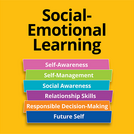
Colours have the power to make us think and feel different emotions. This assignment allows students to dive into the psychology of colours.

This resource contains an abundance of ELA infused, cross-curricular lessons organized by themes for Grades 4, 5 and 6. Non-fiction, poetry and fiction reading lessons are all included.
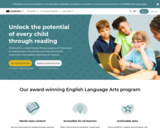
"CommonLit delivers high-quality, free instructional materials to support literacy development for students in grades 3-12. Our resources are:
Flexible;
Research-Based;
Created by teachers, for teachers.
They believe in the transformative power of a great text, and a great question. That’s why we are committed to keeping CommonLit completely free, forever." (CommonLit site)
Teachers can search for content by grade, theme, content type, genres, literary devices, and more. Alternative options are offered for students that may require adaptations for reading an easier level.
Parent guides are also provided.
Benchmark and ongoing assessments are available.
360 Curriculum provides full integrated units E.g., Unit 1 Characters Who Change and Grow which includes a baseline assessment, vocabulary activities, reading lessons, writing lessons, quiz, grammar activities, media exploration, discussion, and a culminating task.